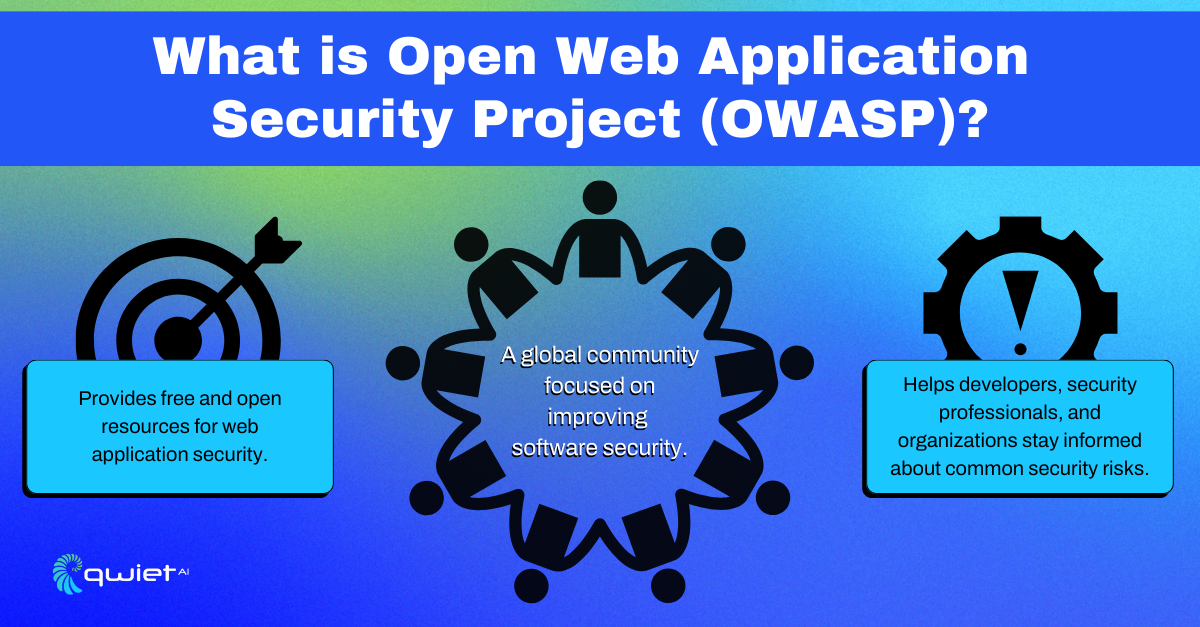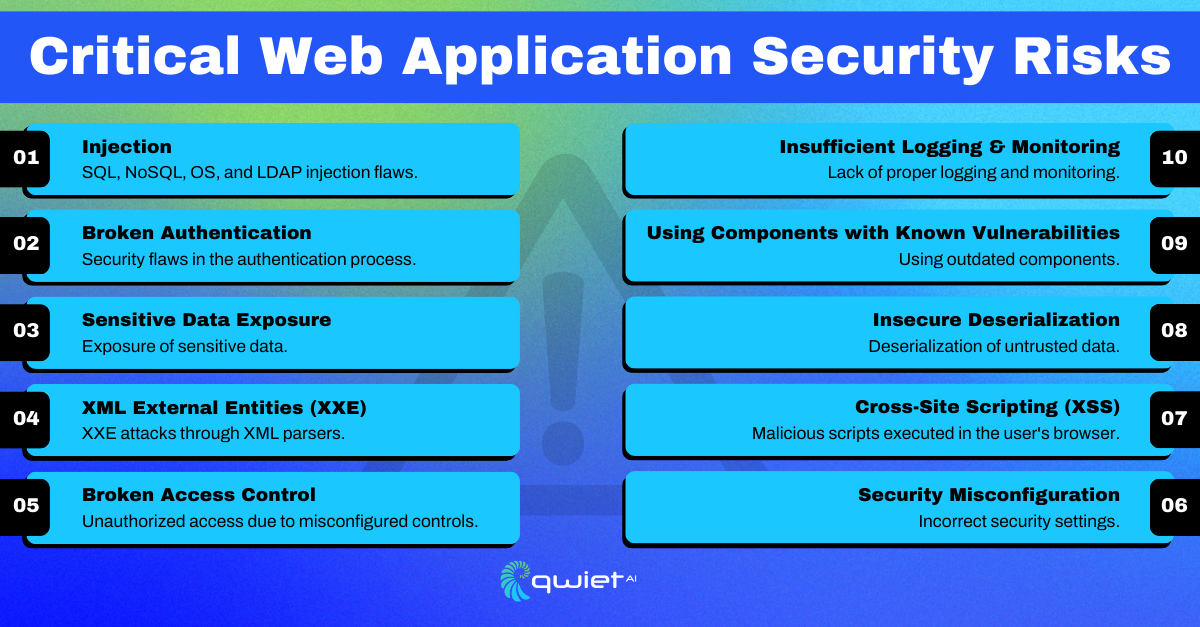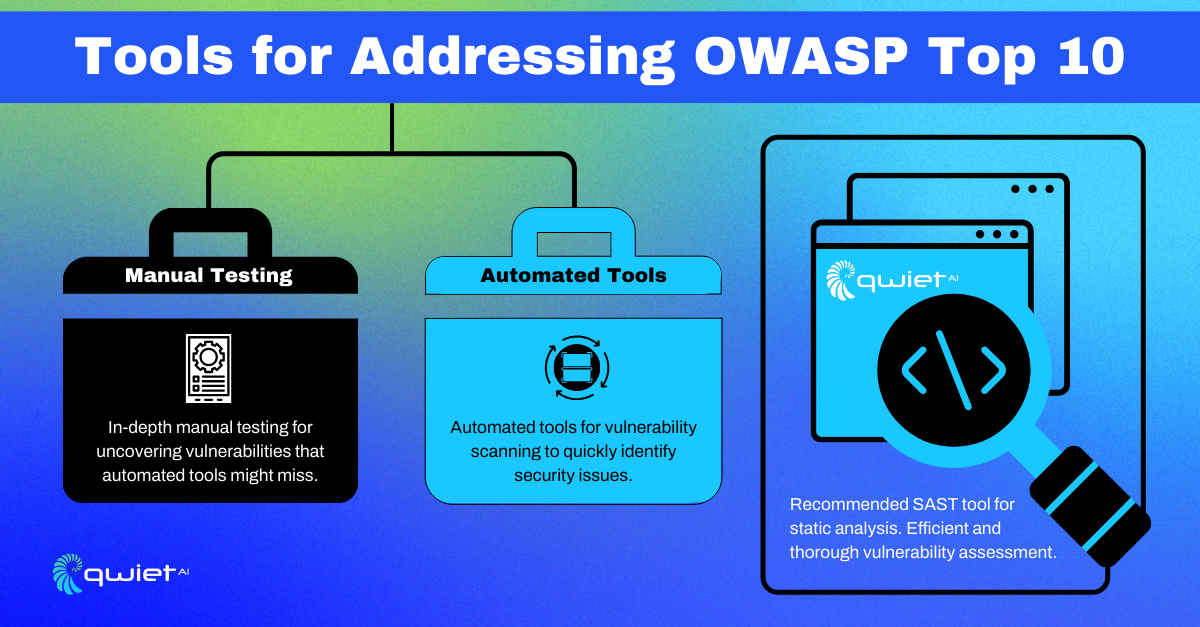What is the OWASP Top 10?

OWASP, or the Open Web Application Security Project, is a global non-profit dedicated to improving software security. It provides tools, guides, and educational materials to help developers and security professionals build more secure applications. OWASP is known for its contributions to setting industry standards in application security.
The OWASP Top 10 is a widely recognized list that highlights the most critical security risks in web applications. Since its first release in 2003, it has been regularly updated to reflect the evolving threat landscape. The list’s main goal is to raise awareness and guide developers and security teams in effectively addressing these vulnerabilities.
Key Vulnerabilities of OWASP Top 10

Injection
Injection flaws happen when untrusted data is mistakenly treated as part of a command or query, allowing attackers to execute harmful commands or access unauthorized data. This issue commonly occurs in SQL, NoSQL, OS commands, and LDAP queries, where data and code aren’t properly separated.
To prevent these vulnerabilities, use parameterized queries to treat data separately from code. Input validation is also important—ensure your application only accepts expected data formats. Applying least privilege principles to database accounts limits potential damage, and a web application firewall (WAF) can help filter out malicious inputs.
Broken Authentication
Broken authentication occurs when an application’s login and session management systems are not secure, allowing attackers to bypass authentication controls. This can result from weak passwords, poor session management, or improper credential storage, making it easier for attackers to gain unauthorized access.
To secure authentication, enforce strong password policies and add multi-factor authentication (MFA) for an extra layer of security. Store passwords using strong hashing algorithms like bcrypt, and manage sessions securely by regenerating session IDs after login.
Sensitive Data Exposure
Sensitive data exposure occurs when an application fails to protect personal data, financial information, or credentials, making them accessible to unauthorized users. This often happens due to weak encryption, improper data handling, or inadequate security controls.
To mitigate these risks, encrypt sensitive data at rest and in transit using strong encryption standards. Use secure communication protocols like HTTPS/TLS to protect data during transmission. Additionally, consider implementing data masking or tokenization to obscure sensitive information, and regularly review your encryption practices to stay ahead of potential threats.
XML External Entities (XXE)
XML External Entities (XXE) attacks exploit vulnerabilities in XML parsers that process external entities, leading to unauthorized access to sensitive data, remote code execution, or denial-of-service attacks. This happens when applications improperly handle XML input, exposing internal files or networks.
To prevent XXE attacks, disable DTDs (Document Type Definitions) in XML parsers and use more secure formats like JSON. Implement strict input validation and opt for secure libraries not susceptible to XXE vulnerabilities.
Broken Access Control
Broken access control occurs when an application fails to properly enforce user permissions, allowing unauthorized actions such as accessing or modifying data. This can result from flaws like URL manipulation or improper implementation of access control mechanisms.
To mitigate these risks, implement role-based access control (RBAC) to ensure users only have access to necessary resources. Regularly test and review access controls during development to identify and fix any gaps that could be exploited.
Security Misconfiguration
Security misconfiguration happens when systems or applications are improperly configured, leaving them vulnerable to attacks. This can include default settings, unnecessary features enabled, or outdated software.
To prevent misconfigurations, use secure defaults, regularly update software, and disable any features or services that are not required. Regular audits and automated configuration management tools can help maintain secure settings across different environments.
Cross-Site Scripting (XSS)
Cross-Site Scripting (XSS) attacks happen when attackers inject malicious scripts into web pages that unsuspecting users visit. These scripts run in the user’s browser, potentially allowing the attacker to steal session cookies, alter the website’s appearance, or redirect users to harmful sites. XSS vulnerabilities usually arise because user input is not properly validated or sanitized before being displayed on a webpage.
Preventing XSS requires a few important steps. Input validation and output encoding are crucial to stop untrusted data from being executed as code. It’s also wise to use security libraries or frameworks that handle output escaping automatically. Implementing Content Security Policy (CSP) headers can reduce the risk by limiting what scripts can run on your site.
Insecure Deserialization
Insecure deserialization occurs when an application deserializes untrusted data, which can lead to serious security issues like arbitrary code execution or privilege escalation. Attackers can manipulate the serialized data to exploit the application, potentially gaining control or causing it to behave unexpectedly.
Avoid deserializing untrusted data whenever possible to reduce the risk of insecure deserialization. If you must deserialize data, use safe serialization formats and enforce strict validation. Adding integrity checks can also help ensure the data hasn’t been tampered with before deserializing.
Using Components with Known Vulnerabilities
Using outdated or vulnerable components, like libraries or frameworks, can introduce significant security risks to your application. Attackers often target these known vulnerabilities to compromise the application, gain unauthorized access, or escalate attacks.
Staying secure means keeping all components up-to-date. Regularly check for updates to libraries and frameworks and use tools to scan dependencies for vulnerabilities. Automated dependency management tools can help keep everything current, reducing the chances that known vulnerabilities will be exploited.
Insufficient Logging & Monitoring
Logging and monitoring are fundamental to keeping your application secure. They provide visibility into what’s happening in your system, making spotting unusual behavior or potential security incidents easier. Without proper logging, you might miss signs of an attack, which could go undetected and cause significant damage.
To set up effective logging and monitoring, focus on capturing important events like login attempts, access to sensitive data, and errors. Use tools that alert you to suspicious activities in real-time, and regularly review your logs to make sure they’re providing the information you need. Having these practices in place helps you stay ahead of potential threats and respond quickly when something goes wrong.
Tools for Addressing OWASP Top 10 Vulnerabilities

Static Application Security Testing (SAST) tools are a great way to catch vulnerabilities early in development. These tools analyze your codebase for security issues without running the code. SAST is particularly effective for spotting problems like injection flaws and broken authentication before they become bigger issues down the line. Integrating SAST into your workflow can address security concerns directly in your code, saving you headaches later.
That said, while SAST is powerful, it shouldn’t be your only line of defense. Manual and penetration testing are also important because they can identify complex vulnerabilities that automated tools might miss. Combining SAST with these approaches, regular code reviews, and secure coding practices gives you a solid foundation to build more secure applications.
Conclusion
The OWASP Top 10 highlights critical vulnerabilities developers must address to maintain secure applications. Regularly monitoring and updating your security practices is essential to avoiding these risks. A SAST tool like Qwiet can help you catch and fix these vulnerabilities early, ensuring your code aligns with OWASP guidelines. Ready to see how Qwiet can enhance your security?
Book a demo today and take the first step toward a more secure codebase.
Read Next
Spring Boot Security Mechanisms
Introduction As businesses increasingly rely on web applications and microservices, securing them becomes important. Spring Boot is popular among developers for creating efficient microservices. This article will guide you through Spring Boot’s security options, from basic setups to advanced configurations. You’ll learn how to integrate these tools to enhance your application’s security.. Basics of Security […]
Securing Python Applications with PyCrypto
Introduction Python is widely used in applications and must be protected from common security threats. This guide introduces PyCrypto, a powerful library for implementing cryptographic techniques in Python applications. You’ll learn how to encrypt and decrypt data, generate secure keys, and ensure data integrity. By reading this post, you’ll gain practical knowledge and step-by-step instructions […]
Data Encryption
Introduction Have you ever wondered how your private info stays safe online? In a world where cyber threats are rising and we share more data than ever, data encryption is our digital guardian angel. This article will take you through how encryption works to protect your information and why it’s more important now than ever. […]